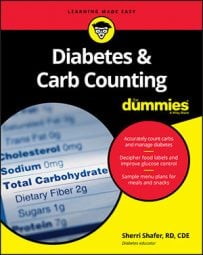| Variable | Consideration |
| Portion size | Excess carb intake can sabotage blood-glucose control efforts. The larger the portion, the larger the amount of glucose that enters the bloodstream. |
| Form | Liquids digest rapidly, so they have the potential to raise blood-glucose levels more sharply than a comparable amount of carb in a solid food. |
| Processing | White, refined breads and processed grains typically cause a sharper blood-glucose rise than the same amount of the whole-grain version. |
| Meal composition | Having a balanced meal with carb, protein, and fat is usually better tolerated than just eating carbohydrate by itself. |
| Concentrated sugars | Sugar, honey, and syrups have concentrated amounts of carb in small servings. It's important to use caution when sweetening foods or having desserts. |
| Glycemic variance | Individual variation exists. You may notice that certain foods affect your blood glucose more than other foods. It may have to do with particle size, level of cooking, or simply the way your body handles that food. |
Controlling portion sizes of foods that pack a blood-glucose punch
Reaching into the box of chocolates and taking one piece of candy isn't a make-or-break situation when it comes to blood-glucose control. One such candy may contain roughly 10 grams of carb and 80 calories. It just boils down to how much willpower you have. If the candy is too tempting, keeping a box of chocolates on your kitchen counter may not be a great idea. If you can muster the self-control to limit your intake, keeping mini treats on hand is feasible.Fruit juice has the potential to raise blood-glucose levels sharply for several reasons: It's liquid, it's concentrated in simple sugars, and it has no protein or fat to slow down digestion. Very small servings may be tolerated, provided your blood-glucose levels are near the lower end of your target range. Large portions of juice are unforgiving even if you eat something with protein and fat at the same time. Tolerance is tough simply because juice is concentrated in carbs. Fruit juice may be used in moderation before or during exercise sessions to prevent hypoglycemia. Blood-glucose results depend on your starting blood-glucose levels, the intensity and duration of the exercise, what type of diabetes you have, and whether or not you use medications such as insulin.
Set reasonable daily carbohydrate intake targets. As long as your diet is balanced and healthy for the most part, you can budget in occasional special treats. Account for the carbs by fitting them into your usual meal plan. That may mean eating a lower-carb meal when you plan to fit in a dessert with carbs. You can also counteract the effects of carbs somewhat by increasing your activity level, which is the focus of the next section.
Adding activity for extra carbs
If you end up slightly overdoing the carb budget, you may be able to offset the effects by adding exercise. A stationary bike or treadmill comes in handy when you need to add a quick exercise session. Weather permitting, a walk outside is another option for burning off the extra carbs and calories. However, you may need to walk or cycle for 20 to 30 minutes just to burn off 100 calories, so think twice before reaching for that pastry with 500 calories.Combining foods to reduce glycemic effect
Digestion rates are affected by how foods are combined. For example, white rice and white bread are refined and low in fiber, so they tend to bump up blood-glucose levels more sharply than whole grains. Putting peanut butter or almond butter on the white bread slows down the digestion and absorption of the bread, which may blunt the blood-glucose rise. Likewise, serving rice with stir-fried vegetables and fish, beef, chicken, pork, or tofu may reduce the glycemic effect of the rice. Of course, you still need to control the portion size of the rice!Altering the order in which you eat the components of your meal
Sometimes blood-glucose levels are higher than desired when you're about to sit down to have a meal. If you typically take insulin to cover your carbs, it may not hurt to give the insulin a head start when you're hyperglycemic at mealtime. After injecting the insulin, you can opt to start with the low-carb or carb-free foods first. Begin with salad, and then work your way through most of the protein and vegetables. Doing so allows the insulin a chance to chisel down the blood-glucose levels somewhat before you munch on carbs.
If you're battling to get blood-glucose levels into a reasonable range, don't try to fit in sweets and treats. Don't overdo the carb portions when your blood-glucose levels are up. Sometimes it takes a few lower-carb meals to get blood-glucose levels back into the target zone. If your blood glucose remains elevated despite diet modification efforts, you may need medication dosage adjustments. Ask your healthcare provider for advice on meds.

